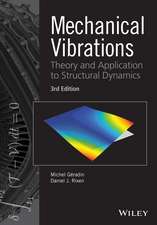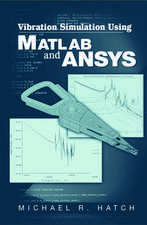Vibration Mechanics: Linear Discrete Systems
Autor M. del Pedro, P. Pahuden Limba Engleză Paperback – 21 sep 2012
| Toate formatele și edițiile | Preț | Express |
|---|---|---|
| Paperback (1) | 947.18 lei 6-8 săpt. | |
| SPRINGER NETHERLANDS – 21 sep 2012 | 947.18 lei 6-8 săpt. | |
| Hardback (1) | 953.65 lei 6-8 săpt. | |
| SPRINGER NETHERLANDS – 30 sep 1991 | 953.65 lei 6-8 săpt. |
Preț: 947.18 lei
Preț vechi: 1155.11 lei
-18% Nou
Puncte Express: 1421
Preț estimativ în valută:
181.30€ • 196.100$ • 152.39£
181.30€ • 196.100$ • 152.39£
Carte tipărită la comandă
Livrare economică 21 aprilie-05 mai
Preluare comenzi: 021 569.72.76
Specificații
ISBN-13: 9789401055543
ISBN-10: 9401055548
Pagini: 352
Ilustrații: XIII, 335 p.
Dimensiuni: 155 x 235 x 18 mm
Greutate: 0.49 kg
Ediția:Softcover reprint of the original 1st ed. 1991
Editura: SPRINGER NETHERLANDS
Colecția Springer
Locul publicării:Dordrecht, Netherlands
ISBN-10: 9401055548
Pagini: 352
Ilustrații: XIII, 335 p.
Dimensiuni: 155 x 235 x 18 mm
Greutate: 0.49 kg
Ediția:Softcover reprint of the original 1st ed. 1991
Editura: SPRINGER NETHERLANDS
Colecția Springer
Locul publicării:Dordrecht, Netherlands
Public țintă
ResearchCuprins
1 Introduction.- 1.1 Brief history.- 1.2 Disruptive or useful vibrations.- 2 The Linear Elementary Oscillator of Mechanics.- 2.1 Definitions and notation.- 2.2 Equation of motion and vibratory states.- 2.3 Modified forms of the equation of motion.- 3 The Free State of the Elementary Oscillator.- 3.1 Conservative free state · Harmonic oscillator.- 3.2 Conservation of energy.- 3.3 Examples of conservative oscillators.- 3.4 Dissipative free state.- 3.5 Energy of the dissipative oscillator.- 3.6 Phase plane graph.- 3.7 Examples of dissipative oscillators.- 4 Harmonic Steady State.- 4.1 Amplitude and phase as a function of frequency.- 4.2 Graph of rotating vectors.- 4.3 Use of complex numbers · Frequency response.- 4.4 Power consumed in the steady state.- 4.5 Natural and resonant angular frequencies.- 4.6 The Nyquist graph.- 4.7 Examples of harmonic steady states.- 5 Periodic Steady State.- 5.1 Fourier series · Excitation and response spectra.- 5.2 Complex form of the Fourier series.- 5.3 Examples of periodic steady states.- 6 Forced State.- 6.1 Laplace transform.- 6.2 General solution of the forced state.- 6.3 Response to an impulse and to a unit step force.- 6.4 Responses to an impulse and to a unit step elastic displacement.- 6.5 Fourier transformation.- 6.6 Examples of forced states.- 7 Electrical Analogues.- 7.1 Generalities.- 7.2 Force-current analogy.- 7.3 Extension to systems with several degrees of freedom · Circuits of forces.- 8 Systems with Two Degrees of Freedom.- 8.1 Generalities · Concept of coupling.- 8.2 Free state and natural modes of the conservative system.- 8.3 Study of elastic coupling.- 8.4 Examples of oscillators with two degrees of freedom.- 9 The Frahm Damper.- 9.1 Definition and differential equations of the system.- 9.2 Harmonic steadystate.- 9.3 Limiting cases of the damping.- 9.4 Optimization of the Frahm damper.- 9.5 Examples of applications.- 9.6 The Lanchester damper.- 10 The Concept of the Generalized Oscillator.- 10.1 Definition and energetic forms of the generalized oscillator.- 10.2 Differentiation of a symmetrical quadratic form · Equations of Lagrange.- 10.3 Examination of particular cases.- 11 Free State of the Conservative Generalized Oscillator.- 11.1 Introduction.- 11.2 Solution of the system by linear combination of specific solutions.- 11.3 Solution of the system by change of coordinates.- 11.4 Response to an initial excitation.- 11.5 Rayleigh quotient.- 11.6 Examples of conservative generalized oscillators.- 12 Free State of the Dissipative Generalized Oscillator.- 12.1 Limits of classical modal analysis.- 12.2 Dissipative free state with real modes.- 12.3 Response to an initial excitation in the case of real modes.- 12.4 General case.- 12.5 Hamiltonian equations for the system.- 12.6 Solution of the differential system.- 12.7 Response to an initial excitation in the general case.- 12.8 Direct search for specific solutions.- 12.9 Another form of the characteristic equation.- 13 Example of Visualization of Complex Natural Modes.- 13.1 Description of the system.- 13.2 Energetic form · Differential equation.- 13.3 Isolation of a mode.- 13.4 Numerical examples.- 13.5 Summary and comments.- 14 Forced State of the Generalized Oscillator.- 14.1 Introduction.- 14.2 Dissipative systems with real modes.- 14.3 Dissipative systems in the general case.- 14.4 Introduction to experimental modal analysis.- Symbol List.
Recenzii
About the French edition:
`The book is well written, uses clear standard notation, and is very well produced. One strength of the book is that for each section, several well-chosen practical examples are treated in detail. . . . this book rates as one of the best written in French.'
Journal of Applied Mechanics, Vol. 57, 1990
`The book is well written, uses clear standard notation, and is very well produced. One strength of the book is that for each section, several well-chosen practical examples are treated in detail. . . . this book rates as one of the best written in French.'
Journal of Applied Mechanics, Vol. 57, 1990















